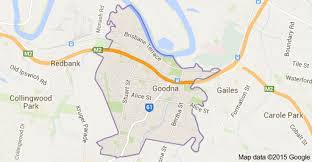Historically Goodna was a farming community, primarily in sugar, cotton, livestock (sheep and cattle), and also had a large local timber industry. Large amounts of timber were taken by bullock teams to the Goodna wharf and shipped to
Ipswich and
Brisbane.
Woogaroo (as it was then known) had extensive beds of
sandstone. In 1826
Patrick Logan established the Woogaroo Quarry to provide building materials for the
Moreton Bay penal colony.
As early as 1841 there was a sheep run called Woogaroo Station, H.S.Russell and Dr.
Stephen Simpson (the Grenier family of South Brisbane were still in New Zealand in 1841 and did not reach Brisbane till 1845 and while having the Grenier Inn at South Brisbane farmed land known as "The Willows" where Archerfield airfield stands today). This name, which referred to a waterhole in the creek was superseded from 1865 onwards by the name Goodna.
By the early 1840s Dr Stephen Simpson, the lands commissioner and magistrate for the Moreton Bay district, was living in a slab hut and farming on the riverbank near the mouth of Woogaroo Creek. As the main road intersected with the track from
Coopers Plains and the river, at the time it was a strategic location for Simpson. In 1851–1852 he purchased 2,000 acres (8 km
2) of land, including 640 acres (2.6 km
2) on Wolston Creek. Other well known pioneers settled or purchased land in the Goodna area: James Holmes arrived in 1851 and established himself as a grazier; Charles Pitt married Thomas Grenier's daughter Mary in 1855 and grew cotton and maize at Redbank Plains. According to "Aldines" Charles was the second to grow cotton in that area and received 400 pounds from the Government of the day. He was also a JP and on the
Purga Divisional Board and involved in the beginnings of the Redbank School. ; Harriet Holmes bought 33 acres (130,000 m
2) in 1860; and
Joshua Jeays, later
Mayor of Brisbane, bought 40 acres (160,000 m
2) in the next year.
Further settlement took place after Goodna was proclaimed a village in 1856. In the following year Joseph and Ellen (née Thompson) Broad built a store on the site, and sold the store later to Edwin Pitt son of Charles and Mary Pitt. Edwin and his wife Cecilia (née Thompson sister of Ellen Broad) ran the store as a mixed business and Cecilia was the postmistress (see Aldines). They survived the
1893 Brisbane flood but a little later built Pitt's Hotel Cecil on the store site. It was later burnt down and the RSL is now on that site. Edwin and Cecilia's daughter Zora Brenda Pitt grew up and learnt to ride in Goodna and she became Royal National Show champion woman rider in the early 1900s, and the cemetery opened in 1859. By 1863 there was a small run to Holmes Inn, where Harriet Holmes was postmistress and the Congregational Church which was also opened in 1863. There was one acting police sergeant and a constable by 1868. W. Law established himself as a blacksmith in 1870, the year in which the Goodna State School opened.
On 30 January 1873 the ceremony of "turning the sod" for the first rail link between Ipswich and Brisbane took place at Goodna. Two thousand people attended the event, most arriving by paddle steamer. To officially start the work, the
Queensland Governor George Phipps, 2nd Marquess of Normanby, used a solid silver spade to dig a small piece of earth and place it in a wheelbarrow.
Cobb and Co coaches stopped at Goodna on their way to and from Brisbane (their only other stops were
Oxley and
Rocklea). This ended after the railway link was completed in 1875.
Daniel Jones built the first sawmill in 1884, which was located below the Catholic Church/School grounds in the paddock that reached from Mill Street to Alice Street (known by locals as 'the mill paddock'). In the smaller paddock immediately behind the Presbyterian Church and Manse stood the wooden 'Honey Shed' used by Daniel's brother Harry in conjunction with his apiary. By the Second World War this use had been discontinued and the site was used by a group of CWA ladies who made camouflage nets for the war effort. The site was also used at one time by the Goodna Scout Group.
By 1888 the population of Goodna was 500, and there were three friendly societies, the
Oddfellows, Loyal Rose of Denmark and
Good Templars. The foundation stone of St Francis Xavier Catholic Church (formerly St Patrick's) had been laid in 1880 by Bishop
James Quinn and opened in the following year. The Catholic school was opened in 1910 and the Sisters of Mercy Convent in 1911. Goodna today retains significant elements of its heritage.
Source: Wikipedia




0 Comments